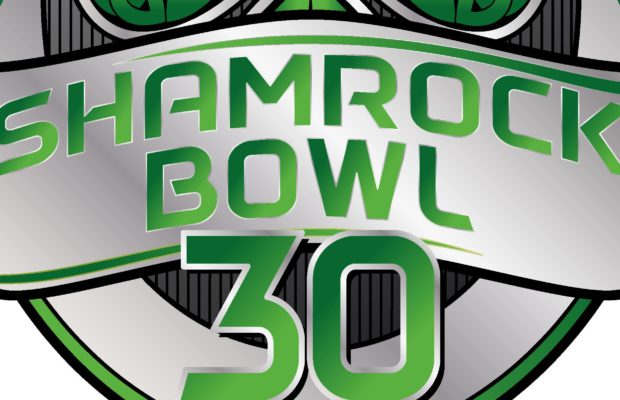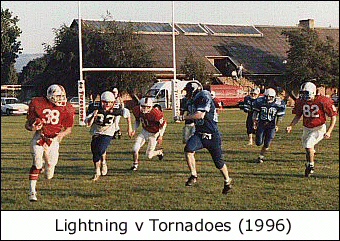Journey to Thirty – History of Ireland’s Championship Game – The Shamrock Bowl

It’s been over 30 years since the inaugural season of the Irish American Football League and a lot has changed over its life span.
The standard of football has grown tremendously with now full contact, flag football and youth leagues well in place. The Irish National side has spent the better part of two years preparing for their first ever international fixture that comes this August against the Dutch Lions. With the pinnacle of the Irish season, Shamrock Bowl 30 less than a week away there is no better time to have a brief reflection of how football has changed in Ireland over the last three decades and by remembering some of the most memorable finals of years past.
EARLY YEARS
Founded in 1984, American Football in Ireland grew out of a fascination for the NFL and a love for the game. In a country predominantly consumed by both soccer and rugby, the idea of America’s game becoming a mainstay on Irish waters would take time. Thus, the first Shamrock Bowl that took place was played in 1986 between the Craigavon Cowboys and the Dublin Celts; two of Ireland’s first ever sides. The Cowboys would win 6-0 in that game but the Dublin Celts would go on to become a force in Irish football. The Celts would win 5 titles in 10 years (including a 45-25 victory against the Cowboys in Shamrock Bowl II) during the early part of the league’s formation. They also became the first Irish side to compete in a Euro Bowl, the then considered Champions League of European football.
Despite showing 13 years worth of promise that included first Bowl wins for the Carrickfergus Knights and Dublin Tornadoes, a lack of organisation and planning forced a hiatus in 1999. However, attempts were made to rekindle the IAFL once again 2 years later. This plan was constructed in 2000 and the league has never looked back. One of the telling moments in American Football history in Ireland, that fell on pure coincidence, came that summer. An American high school, St.Mount Josephs College from Maryland, USA, had made the trip across the Atlantic to face both the Great Britain Lions team and an ‘unknown’ Irish select side. Little knowledge had been gathered of this invitational match but with the college side looking for an organised game, word was spread and anyone who wanted to play showed up and took part. The Irish team may have lost 34-12, but it was this moment that ultimately resurrected the IAFL and became the defining moment of Irish American football’s rebirth.
IAFL’S COMEBACK
As a new era dawned In 2001, four teams would make up the new league structure; the Carrickfergus Knights, Dublin Dragons (rebranded as the South Dublin Panthers), Dublin Rebels and UL Vikings. After the success of its first season, the Dublin Rebels and Carrickfergus Knights would contest Shamrock Bowl XV, which the Rebels won 28-7. This would go on to be the Dublin side’s first of 7 total championship wins.
The Rebels would begin a surge that saw them become the driving force behind the league’s rejuvenation both domestically and internationally. In the summer of 2002, the Rebels would travel to Belgium to compete in international competition, fending off the Charleroi Cougars and French outfits, the Reims Champs and Forbach Taupes on their way to European glory. They later returned in 2003 to defend their trophy and did so successfully.
With football hitting a firm stride in Ireland, it quickly began to grow domestically. The IAFA welcomed more teams year after year and 2003 proved to be a hugely rewarding campaign. Once the Belfast Bulls (defunct), Cork Admirals and Craigavon Cowboys joined the fold, the league comprised of 7 sides which set a new record at that time. The Rebels would defeat the Knights 24-12 in Shamrock Bowl XVII, which attracted large crowds and also television coverage with highlights broadcasted on both TV3 in Ireland and on Sky Sports throughout Europe.
The folllowing year, 2004, would celebrate another accolade in the sports short rise. The season defining final would record the biggest attendance for any IAFL game in history and the final itself is regarded as one of the best finals to have been played in the 30 years. The Rebels would again be 24-22 victors over the Knights.

Dublin Rebels versus the Carrickfergus Knights in 2004
EXPANSION
Over the next 3 years, the Rebels would win their 4th straight championship, the current defending champions the Belfast Trojans kickstarted their tenure and the UL Vikings would win their first Shamrock Bowl. These teams have since set the standard of football in Ireland and continue to be leaders in the sports current progression. In 2008, the league opted to create a DV8’s division that proved to be a defining moment in the IAFA’s forward thinking.
The idea of 8 v 8 full contact, rather than the traditional 11 aside, was designed to help new clubs earn valuable game experience and prepare them for future games at 11-a-side level. It improved both funding and recruitment that increased the longevity of new teams, often a persistent problem in previous years. The developmental league has now been dropped in place of a new IAFL-2 division, but teams such as the North Kildare Reapers and student sides like University College Dublin and 2015 finalists Trinity College have greatly benefited and are now playing at high levels.
The following season, Shamrock Bowl XXIII in 2009 would mark a rare occasion as the only final to reach overtime after the game finished 6-6 after 4 quarters. The UL Vikings would eventually come out on top, defeating the Dublin Rebels 9-6 to win their third Shamrock Bowl, with kicker Daniel Smith converting the decisive kick. The Rebels would enact revenge however in 2010 with a 15-0 shutout against Limerick.
THE PRESENT
In 2012 the IAFA once again prepared a reshuffle of the league’s format by dividing the previously 3 tier division structure into a two tier league, creating the Shamrock Bowl Conference North and South. This allowed teams a full schedule of 8 games and also helped add to the growing competitiveness in order to boost the standard of play. This structure is still the format that is implemented in the IAFL today. Along with the change, 2012 would also witness a power shift across Ireland. The current champions, the Belfast Trojans would commence their reign atop the Irish League by winning their first ever Shamrock Bowl in a dramatic 16-14 cliffhanger against the UL Vikings that summer. The game would be remembered for Rick Duffield’s last second field goal that clinched them the title against a seemingly unstoppable Vikings side.
The last four championships have since all been won by the Trojans, including back-to-back victories against the aforementioned Trinity College. One of those games was played in torrential rain and dubbed the ‘Thunder Bowl’, when a Connor Whitla pick-6 was all that separated the sides in an intense defensive battle in 2014. The same sides also contested the final in 2015 with the Trojans winning 28-14.
So here we reach the present day, with the IAFL in a much better condition and exceeding expectations. The Irish American Football Association has worked tirelessly, continuing to push the boundaries of what Irish Football is capable of achieving. The goal is to improve the quality and publicity of this great game across the country so that more people can become aware of the world’s fastest growing sport on Irish soil.
Since its initiation in 1984, the IAFL now stands at 23 full contact sides, with more expected to join in the coming years. There is also a full calendar year of flag football and the first youth football program started in 2014. With the number of interested players and teams registering with the IAFA, the league could soon be making the strides needed to compete with some of the top leagues across Europe. America’s game has accelerated across the country and the demand is at an all time high.
This Sunday, Tallaght Stadium in Dublin will be the host of Shamrock Bowl 30 when the Belfast Trojans face the Dublin Rebels. The final will not only be a great footballing spectacle, but more importantly it signifies how far we have come throughout this ever developing journey. With plenty of optimism and excitement surrounding Irish American Football, the future looks very promising. Here’s to the next 30 years!
